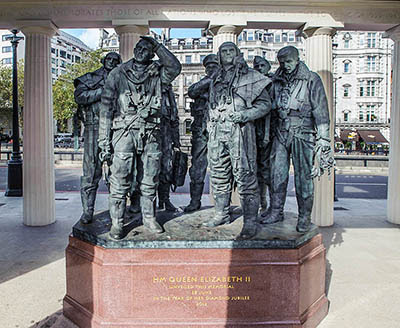An Unsolved Mystery Part 1
After the Dessau raid, in the early hours of March 8, 1945, Douglas Hicks, Gordon Nicol, Gerard Kelleher and David Yemen were in custody in the area of Magdeburg, being logged as POWs.
That same morning, a Canadian airman, having baled out from his aircraft, was discovered hiding in a barn in the small German village of Klein Flöthe, located approximately 70 km southeast of Hanover.
Prior to being led away, the airman spoke to the town’s school-teacher, Ernst Vosmer, who had a limited knowledge of English. The brown-haired, blue-eyed airman explained he had parachuted from a disabled aircraft about 5 km away and walked into town. The airman identified himself as an Officer and said that prior to the war, he had been a farmer from outside of Winnipeg.
Vosmer recalled the airman pulled out his pay book to show him his name, but when asked later, the teacher could only remember the pay book had been barely legible and the name had ended in ‘Tiss’ or ‘Liss.’ He later expressed to the RAF investigator, Flight Lieutenant R. B. Binks, that had he known how important this name would be, he would have paid more attention.
Looking out of his schoolhouse window an hour later, Vosmer saw the airman in the company of Wilhelm Bandermann, a widely disliked member of the village and member of the local Volkssturm.
Vosmer described seeing Bandermann carrying a gun, escorting the airman along with another man who was also well known in the village. The trio were walking in the direction of the nearest prisoner-of-war camp 5 km south of town, so Vosmer assumed they were heading there.
Around noon, Vosmer noticed Bandermann returning to the village by himself. That afternoon, when the labourers returned from the fields, word spread through the village that the airman had been shot in the nearby wood. The rumour originated from two labourers, one from Russia, the other from Italy, both of who had been repatriated by the time the investigation had begun. The labourers were said to have seen the unknown airman and a local man enter the woods that morning. Two shots were fired and five minutes after entering, the local man emerged from the wood alone and returned to the village.
On hearing news of these events, the mayor of the neighbouring village of Altenrode and the wife of one of his employees went into the wood to investigate. One kilometre south of Altenrode, they found the dead body of an airman, still dressed in his flying suit, covered in blood and with two bullet holes in his back. Near the body the pair found ashes which appeared to be from burned paper. The airman was buried in Altenrode Cemetery, the grave identified with a white cross marked “Unknown Canadian Airman.”
In a subsequent report two weeks later to the Air Ministry, Investigator Binks asked the reader to recommend whether to continue to register the remains as an unknown Canadian or a suggested identity of Flying Officer Robert Douglas Harris.
Read Unsolved Mystery Part 2
That same morning, a Canadian airman, having baled out from his aircraft, was discovered hiding in a barn in the small German village of Klein Flöthe, located approximately 70 km southeast of Hanover.
Prior to being led away, the airman spoke to the town’s school-teacher, Ernst Vosmer, who had a limited knowledge of English. The brown-haired, blue-eyed airman explained he had parachuted from a disabled aircraft about 5 km away and walked into town. The airman identified himself as an Officer and said that prior to the war, he had been a farmer from outside of Winnipeg.
Vosmer recalled the airman pulled out his pay book to show him his name, but when asked later, the teacher could only remember the pay book had been barely legible and the name had ended in ‘Tiss’ or ‘Liss.’ He later expressed to the RAF investigator, Flight Lieutenant R. B. Binks, that had he known how important this name would be, he would have paid more attention.
Looking out of his schoolhouse window an hour later, Vosmer saw the airman in the company of Wilhelm Bandermann, a widely disliked member of the village and member of the local Volkssturm.
Vosmer described seeing Bandermann carrying a gun, escorting the airman along with another man who was also well known in the village. The trio were walking in the direction of the nearest prisoner-of-war camp 5 km south of town, so Vosmer assumed they were heading there.
Around noon, Vosmer noticed Bandermann returning to the village by himself. That afternoon, when the labourers returned from the fields, word spread through the village that the airman had been shot in the nearby wood. The rumour originated from two labourers, one from Russia, the other from Italy, both of who had been repatriated by the time the investigation had begun. The labourers were said to have seen the unknown airman and a local man enter the woods that morning. Two shots were fired and five minutes after entering, the local man emerged from the wood alone and returned to the village.
On hearing news of these events, the mayor of the neighbouring village of Altenrode and the wife of one of his employees went into the wood to investigate. One kilometre south of Altenrode, they found the dead body of an airman, still dressed in his flying suit, covered in blood and with two bullet holes in his back. Near the body the pair found ashes which appeared to be from burned paper. The airman was buried in Altenrode Cemetery, the grave identified with a white cross marked “Unknown Canadian Airman.”
In a subsequent report two weeks later to the Air Ministry, Investigator Binks asked the reader to recommend whether to continue to register the remains as an unknown Canadian or a suggested identity of Flying Officer Robert Douglas Harris.
Read Unsolved Mystery Part 2

Comments
Post a Comment